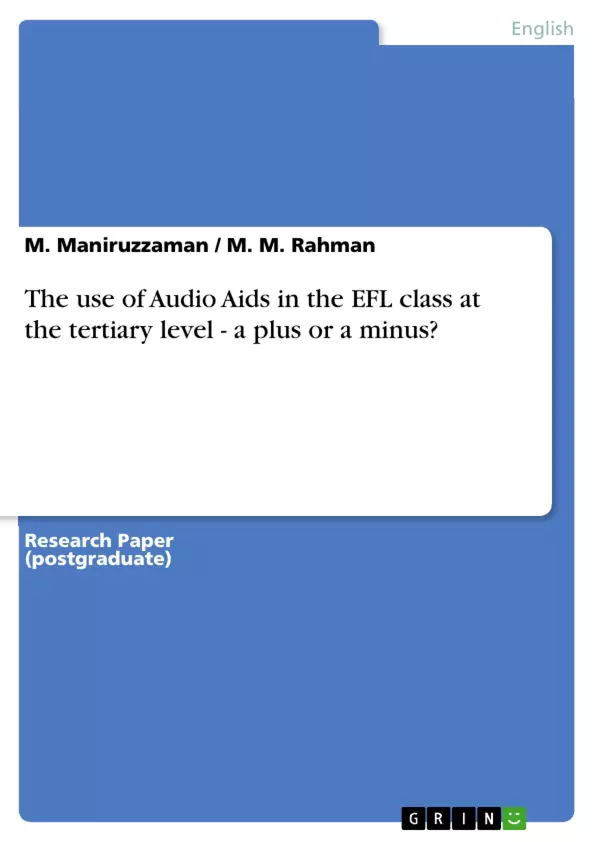
The use of Audio Aids in the EFL class at the tertiary level - a plus or a minus?
Forschungsarbeit, 2008
23 Seiten, Note: none
Leseprobe
Table of Contents
- Abstract
- Introduction
- Audio-aids
- Different Teaching Aids
- Research Design and Methodology
- Subjects
Objectives and Key Themes
The main objective of this study is to investigate the use of audio aids in English as a Foreign Language (EFL) classes at the tertiary level in Bangladesh, exploring their effectiveness and the factors limiting their wider implementation. The study aims to understand teacher and student perspectives on the use of these aids.
- The effectiveness of audio aids in EFL teaching at the tertiary level.
- Factors hindering the use of audio aids in Bangladeshi tertiary EFL classrooms.
- Teacher and student perceptions of the benefits and drawbacks of using audio aids.
- The role of technology in expanding the scope of audio aids in language learning.
- Recommendations for improving the utilization of audio aids in EFL teaching.
Chapter Summaries
Abstract: This study investigates the use of audio aids in tertiary-level EFL classes in Bangladesh. It explores the potential benefits of these aids as learning facilitators and teaching tools, while also examining the limitations related to teacher training, equipment, materials, and administrative support. The study concludes that while audio aids are beneficial, their optimal use requires addressing these significant constraints.
Introduction: This chapter introduces the challenges of creating engaging and effective second/foreign language materials. It contrasts traditional chalk-and-talk methods with communicative language teaching approaches, highlighting the importance of aligning teaching methods and materials with learners' needs and interests. The chapter emphasizes the potential of audio aids to enhance engagement and learning outcomes.
Audio-aids: This section defines audio aids as audible learning tools providing imagery and encompassing various readily available technologies. It emphasizes their versatility in modifying teaching methods, capturing learner attention, reducing fatigue, and boosting engagement, particularly for skills like listening and speaking. The section underlines the potential of audio aids to create more dynamic and effective learning environments.
Different Teaching Aids: This section discusses how different teaching aids, particularly the use of native speaker voices on audio tapes, enhance learner enthusiasm and understanding of linguistic and communicative aspects. It highlights the lifelike quality audio aids add to printed materials and their effectiveness in engaging even less motivated students. The section underscores the importance of purpose-oriented design and application of audio aids, referencing Pike's (1997) suggestions on maximizing their effectiveness.
Research Design and Methodology: This section details the research methodology, including the sample population of 32 university teachers and 120 students from both public and private universities in Dhaka, Bangladesh. It describes the participants' linguistic backgrounds and the rationale behind the selected institutions. The section sets the stage for the presentation and analysis of the research findings (which are not included in this preview).
Keywords
Teaching EFL, tertiary level, audio aids, communicative language teaching, teacher training, language learning, Bangladesh.
Frequently Asked Questions: A Comprehensive Language Preview on Audio Aids in EFL Teaching
What is the main focus of this study?
This study investigates the effectiveness of audio aids in English as a Foreign Language (EFL) classes at the tertiary level in Bangladesh. It examines their impact on learning, identifies factors limiting their wider use, and explores teacher and student perspectives.
What are the key objectives of the research?
The research aims to determine the effectiveness of audio aids in tertiary-level EFL teaching in Bangladesh; identify factors hindering their use in Bangladeshi classrooms; understand teacher and student perceptions of the benefits and drawbacks; explore the role of technology in expanding the use of audio aids; and provide recommendations for improving their utilization in EFL teaching.
What is included in the Table of Contents?
The Table of Contents covers an Abstract, Introduction, a section on Audio-aids, Different Teaching Aids, and Research Design and Methodology (including details on the subjects involved).
What are the key themes explored in the study?
Key themes include the effectiveness of audio aids in EFL teaching, the challenges and limitations in their implementation (such as teacher training, equipment, and materials), teacher and student perceptions, the role of technology, and recommendations for improved usage.
What is the methodology of the research?
The research involved a sample of 32 university teachers and 120 students from both public and private universities in Dhaka, Bangladesh. The study describes the participants' linguistic backgrounds and the rationale for selecting these institutions. The specific data analysis and findings are not included in this preview.
What are the chapter summaries?
The provided summaries describe the purpose and content of each chapter: The Abstract outlines the study's focus and conclusion; the Introduction discusses challenges in EFL material creation and the potential of audio aids; the Audio-aids section defines and details the benefits of these aids; Different Teaching Aids explores the use of various aids and their impact on learning; and the Research Design and Methodology section explains the research approach and participants.
What are the keywords associated with this research?
Keywords include Teaching EFL, tertiary level, audio aids, communicative language teaching, teacher training, language learning, and Bangladesh.
What types of audio aids are discussed?
The study broadly defines audio aids as audible learning tools providing imagery and encompassing various readily available technologies. Specific examples or technologies are not detailed in this preview.
What are the benefits of using audio aids in EFL teaching, according to this preview?
The preview highlights benefits such as increased learner engagement, improved listening and speaking skills, reduced learner fatigue, and the creation of more dynamic learning environments. It also mentions the added realism and enhanced understanding provided by native speaker voices.
What are some limitations or challenges to the use of audio aids identified in this preview?
The preview mentions limitations related to teacher training, equipment availability, suitable materials, and administrative support. These factors are highlighted as constraints to the optimal use of audio aids, even though their benefits are acknowledged.
Details
- Titel
- The use of Audio Aids in the EFL class at the tertiary level - a plus or a minus?
- Veranstaltung
- Teaching EFL
- Note
- none
- Autoren
- Dr. M. Maniruzzaman (Autor:in), M. M. Rahman (Autor:in)
- Erscheinungsjahr
- 2008
- Seiten
- 23
- Katalognummer
- V93336
- ISBN (eBook)
- 9783638069045
- ISBN (Buch)
- 9783640109203
- Dateigröße
- 506 KB
- Sprache
- Englisch
- Schlagworte
- Audio Aids Teaching
- Produktsicherheit
- GRIN Publishing GmbH
- Preis (Ebook)
- US$ 17,99
- Preis (Book)
- US$ 19,99
- Arbeit zitieren
- Dr. M. Maniruzzaman (Autor:in), M. M. Rahman (Autor:in), 2008, The use of Audio Aids in the EFL class at the tertiary level - a plus or a minus?, München, Page::Imprint:: GRINVerlagOHG, https://www.diplomarbeiten24.de/document/93336
- Autor werden
- Ihre Optionen
- Vertriebskanäle
- Premium Services
- Autorenprofil
- Textarten und Formate
- Services für Verlage, Hochschulen, Unternehmen

- © GRIN Publishing GmbH.
- Alle Inhalte urheberrechtlich geschützt. Kopieren und verbreiten untersagt.
- info@grin.com
- AGB
- Open Publishing
Der GRIN Verlag hat sich seit 1998 auf die Veröffentlichung akademischer eBooks und Bücher spezialisiert. Der GRIN Verlag steht damit als erstes Unternehmen für User Generated Quality Content. Die Verlagsseiten GRIN.com, Hausarbeiten.de und Diplomarbeiten24 bieten für Hochschullehrer, Absolventen und Studenten die ideale Plattform, wissenschaftliche Texte wie Hausarbeiten, Referate, Bachelorarbeiten, Masterarbeiten, Diplomarbeiten, Dissertationen und wissenschaftliche Aufsätze einem breiten Publikum zu präsentieren.
Kostenfreie Veröffentlichung: Hausarbeit, Bachelorarbeit, Diplomarbeit, Dissertation, Masterarbeit, Interpretation oder Referat jetzt veröffentlichen!
- GRIN Verlag GmbH
-
- Nymphenburger Str. 86
- 80636
- Munich, Deutschland
- +49 89-550559-0
- +49 89-550559-10
- info@grin.com
-









